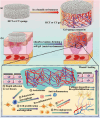An advanced chitosan based sponges dressing system with antioxidative, immunoregulation, angiogenesis and neurogenesis for promoting diabetic wound healing
- PMID: 39659839
- PMCID: PMC11629240
- DOI: 10.1016/j.mtbio.2024.101361
An advanced chitosan based sponges dressing system with antioxidative, immunoregulation, angiogenesis and neurogenesis for promoting diabetic wound healing
Abstract
Promoting wound nerve regeneration and synchronously initiating angiogenesis are critical factors in the healing process of diabetic wounds. However, existing research on diabetic wounds mainly focuses on angiogenesis, bacterial infection and reactive oxygen species, often failing to coordinate neurogenesis and angiogenesis. To coordinate the symbiosis of nerves and blood vessels in the diabetic wounds, we successfully designed a multifunctional chitosan (CS)-based sponges by regulating the structure of CS specifically for diabetic wound healing. This sponge, which facilitates effective exudate transfer and modulates the wound microenvironment, was constructed using hydroxybutyl CS grafted with thioctic acid (TA), named as HCT sponge. When applied in a humid environment, the hydrophobic side chains of the HCT sponge interact with self-assembled hydrophobic domains, forming gel-sponge composite. Experimental results showed that the adhesion strength of the HCT sponge to wet porcine skin was 70.3 kPa. Additionally, the sponge exhibited favorable degradability, cytocompatibility and antioxidant properties. As it is shown in the experiments in vitro, sponge can not only promote cell proliferation, migration, and blood vessel formation, but also promote M2 macrophage polarization. Moreover, the rat liver and femoral artery injury model validated that the HCT sponge can effectively treat heavy bleeding from wounds efficacy through quickly sealing wounds and the formation of multiple hemostatic dams. In vivo studies indicated that the HCT sponge significantly accelerated the diabetic wound healing process compared to the recombinant bovine basic fibroblast growth factor gel, achieving a better recovery from the HCT sponge after 15 days. Pathological results show that the designed novel sponge holds considerable promise for treating diabetic wound, allowing regenerative neurogenesis and angiogenesis at the wound site, which provides a significant potential for further improving clinical applications.
Keywords: Angiogenesis; CS-based sponges; Diabetic wound healing; Nerve regeneration; Wet tissue adhesion.
© 2024 The Authors. Published by Elsevier Ltd.
Conflict of interest statement
The authors declare that no conflicts of financial interests or personal relationships have influenced the work reported in this paper.
Figures













Similar articles
-
Multifunctional carboxymethyl chitosan-based sponges loaded with epigallocatechin-3-gallate for accelerating wound healing in diabetic rats with full-thickness burns.Carbohydr Polym. 2025 Feb 15;350:123025. doi: 10.1016/j.carbpol.2024.123025. Epub 2024 Nov 16. Carbohydr Polym. 2025. PMID: 39647940
-
26SCS-Loaded SilMA/Col Composite Sponge with Well-Arranged Layers Promotes Angiogenesis-Based Diabetic Wound Repair by Mediating Macrophage Inflammatory Response.Molecules. 2024 Apr 17;29(8):1832. doi: 10.3390/molecules29081832. Molecules. 2024. PMID: 38675654 Free PMC article.
-
Polymer Composite Sponges with Inherent Antibacterial, Hemostatic, Inflammation-Modulating and Proregenerative Performances for Methicillin-Resistant Staphylococcus aureus-Infected Wound Healing.Adv Healthc Mater. 2021 Nov;10(22):e2101247. doi: 10.1002/adhm.202101247. Epub 2021 Sep 2. Adv Healthc Mater. 2021. PMID: 34473428
-
Injectable Nanocomposite Hydrogel for Accelerating Diabetic Wound Healing Through Inflammatory Microenvironment Regulation.Int J Nanomedicine. 2025 Feb 6;20:1679-1696. doi: 10.2147/IJN.S505918. eCollection 2025. Int J Nanomedicine. 2025. PMID: 39931526 Free PMC article.
-
Update on the Study of Angiogenesis in Surgical Wounds in Patients with Childhood Obesity.Biomedicines. 2025 Feb 5;13(2):375. doi: 10.3390/biomedicines13020375. Biomedicines. 2025. PMID: 40002788 Free PMC article. Review.
Cited by
-
A multifunctional parathyroid hormone-related supramolecular peptide-loaded dual network hydrogel for radiation-induced wound repair.Mater Today Bio. 2025 Apr 29;32:101807. doi: 10.1016/j.mtbio.2025.101807. eCollection 2025 Jun. Mater Today Bio. 2025. PMID: 40469697 Free PMC article.
-
Jellyfish Collagen Grafted with Hydroxybutyl Chitosan and Protocatechuic Acid Adhesive Sponge with Antibacterial Activity for Rapid Hemostasis.ACS Omega. 2025 Jan 13;10(3):2986-2995. doi: 10.1021/acsomega.4c06103. eCollection 2025 Jan 28. ACS Omega. 2025. PMID: 39895763 Free PMC article.
-
A temperature-sensitive chitosan hydrogels loaded with nano-zinc oxide and exosomes from human umbilical vein endothelial cells accelerates wound healing.Regen Ther. 2025 May 17;30:63-74. doi: 10.1016/j.reth.2025.04.020. eCollection 2025 Dec. Regen Ther. 2025. PMID: 40491560 Free PMC article.
References
-
- Jaul E. Non-healing wounds: the geriatric approach. Arch. Gerontol. Geriatr. 2009;49(2):224–226. - PubMed
-
- Xiong Y., Lin Z., Bu P., Yu T., Endo Y., Zhou W., Sun Y., Cao F., Dai G., Hu Y., Lu L., Chen L., Cheng P., Zha K., Shahbazi M.A., Feng Q., Mi B., Liu G. A whole-course-repair system based on neurogenesis-angiogenesis crosstalk and macrophage reprogramming promotes diabetic wound healing. Adv. Mater. 2023;35(19) - PubMed
-
- Butenko S., Nagalla R.R., Guerrero Juarez C.F., Palomba F., David L.M., Nguyen R.Q., Gay D., Almet A.A., Digman M.A., Nie Q., Scumpia P.O., Plikus M.V., Liu W.F. Hydrogel crosslinking modulates macrophages, fibroblasts, and their communication, during wound healing. Nat. Commun. 2024;15(1):6820. - PMC - PubMed
-
- Fan X., Huang J., Zhang W., Su Z., Li J., Wu Z., Zhang P. A multifunctional, tough, stretchable, and transparent curcumin hydrogel with potent antimicrobial, antioxidative, anti-inflammatory, and angiogenesis capabilities for diabetic wound healing. ACS Appl. Mater. Interfaces. 2024;16(8):9749–9767. - PubMed
LinkOut - more resources
Full Text Sources
Research Materials

